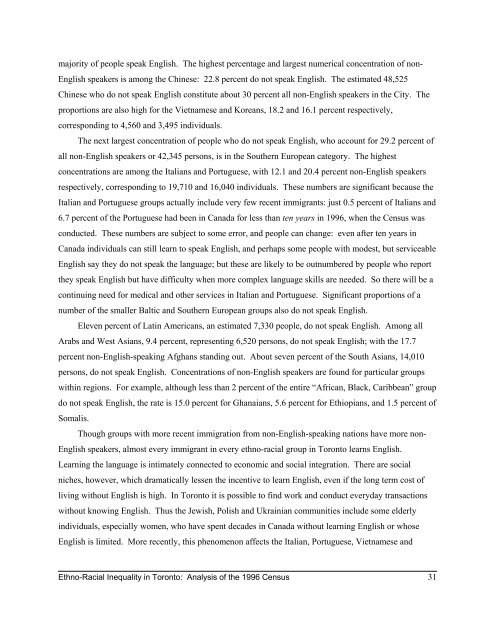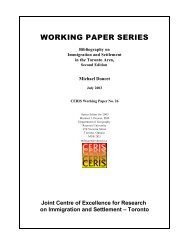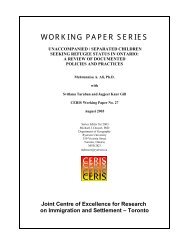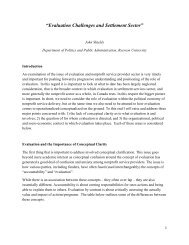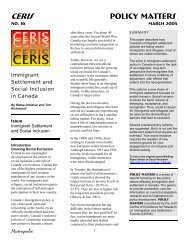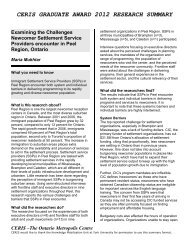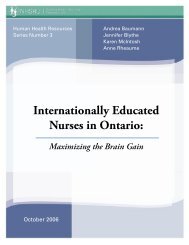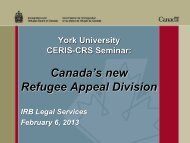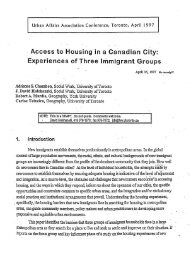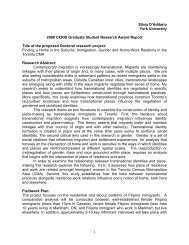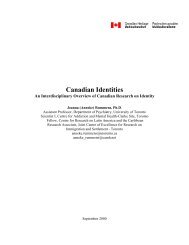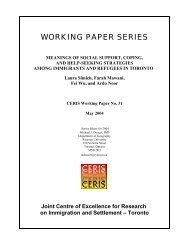Ethno-Racial Inequality in the City of Toronto: An Analysis of the ...
Ethno-Racial Inequality in the City of Toronto: An Analysis of the ...
Ethno-Racial Inequality in the City of Toronto: An Analysis of the ...
You also want an ePaper? Increase the reach of your titles
YUMPU automatically turns print PDFs into web optimized ePapers that Google loves.
majority <strong>of</strong> people speak English. The highest percentage and largest numerical concentration <strong>of</strong> non-English speakers is among <strong>the</strong> Ch<strong>in</strong>ese: 22.8 percent do not speak English. The estimated 48,525Ch<strong>in</strong>ese who do not speak English constitute about 30 percent all non-English speakers <strong>in</strong> <strong>the</strong> <strong>City</strong>. Theproportions are also high for <strong>the</strong> Vietnamese and Koreans, 18.2 and 16.1 percent respectively,correspond<strong>in</strong>g to 4,560 and 3,495 <strong>in</strong>dividuals.The next largest concentration <strong>of</strong> people who do not speak English, who account for 29.2 percent <strong>of</strong>all non-English speakers or 42,345 persons, is <strong>in</strong> <strong>the</strong> Sou<strong>the</strong>rn European category. The highestconcentrations are among <strong>the</strong> Italians and Portuguese, with 12.1 and 20.4 percent non-English speakersrespectively, correspond<strong>in</strong>g to 19,710 and 16,040 <strong>in</strong>dividuals. These numbers are significant because <strong>the</strong>Italian and Portuguese groups actually <strong>in</strong>clude very few recent immigrants: just 0.5 percent <strong>of</strong> Italians and6.7 percent <strong>of</strong> <strong>the</strong> Portuguese had been <strong>in</strong> Canada for less than ten years <strong>in</strong> 1996, when <strong>the</strong> Census wasconducted. These numbers are subject to some error, and people can change: even after ten years <strong>in</strong>Canada <strong>in</strong>dividuals can still learn to speak English, and perhaps some people with modest, but serviceableEnglish say <strong>the</strong>y do not speak <strong>the</strong> language; but <strong>the</strong>se are likely to be outnumbered by people who report<strong>the</strong>y speak English but have difficulty when more complex language skills are needed. So <strong>the</strong>re will be acont<strong>in</strong>u<strong>in</strong>g need for medical and o<strong>the</strong>r services <strong>in</strong> Italian and Portuguese. Significant proportions <strong>of</strong> anumber <strong>of</strong> <strong>the</strong> smaller Baltic and Sou<strong>the</strong>rn European groups also do not speak English.Eleven percent <strong>of</strong> Lat<strong>in</strong> Americans, an estimated 7,330 people, do not speak English. Among allArabs and West Asians, 9.4 percent, represent<strong>in</strong>g 6,520 persons, do not speak English; with <strong>the</strong> 17.7percent non-English-speak<strong>in</strong>g Afghans stand<strong>in</strong>g out. About seven percent <strong>of</strong> <strong>the</strong> South Asians, 14,010persons, do not speak English. Concentrations <strong>of</strong> non-English speakers are found for particular groupswith<strong>in</strong> regions. For example, although less than 2 percent <strong>of</strong> <strong>the</strong> entire “African, Black, Caribbean” groupdo not speak English, <strong>the</strong> rate is 15.0 percent for Ghanaians, 5.6 percent for Ethiopians, and 1.5 percent <strong>of</strong>Somalis.Though groups with more recent immigration from non-English-speak<strong>in</strong>g nations have more non-English speakers, almost every immigrant <strong>in</strong> every ethno-racial group <strong>in</strong> <strong>Toronto</strong> learns English.Learn<strong>in</strong>g <strong>the</strong> language is <strong>in</strong>timately connected to economic and social <strong>in</strong>tegration. There are socialniches, however, which dramatically lessen <strong>the</strong> <strong>in</strong>centive to learn English, even if <strong>the</strong> long term cost <strong>of</strong>liv<strong>in</strong>g without English is high. In <strong>Toronto</strong> it is possible to f<strong>in</strong>d work and conduct everyday transactionswithout know<strong>in</strong>g English. Thus <strong>the</strong> Jewish, Polish and Ukra<strong>in</strong>ian communities <strong>in</strong>clude some elderly<strong>in</strong>dividuals, especially women, who have spent decades <strong>in</strong> Canada without learn<strong>in</strong>g English or whoseEnglish is limited. More recently, this phenomenon affects <strong>the</strong> Italian, Portuguese, Vietnamese and<strong>Ethno</strong>-<strong>Racial</strong> <strong>Inequality</strong> <strong>in</strong> <strong>Toronto</strong>: <strong>An</strong>alysis <strong>of</strong> <strong>the</strong> 1996 Census 31


